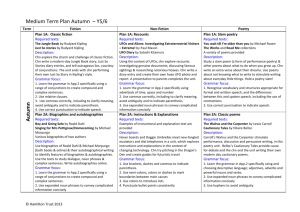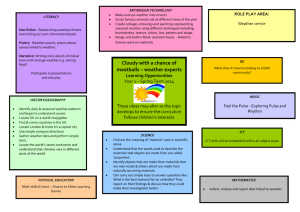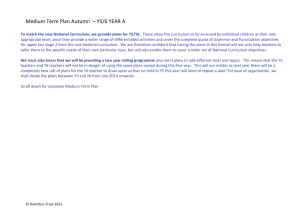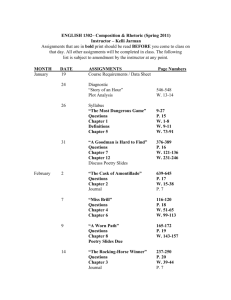WB 190208 - pgfl.org.uk
advertisement
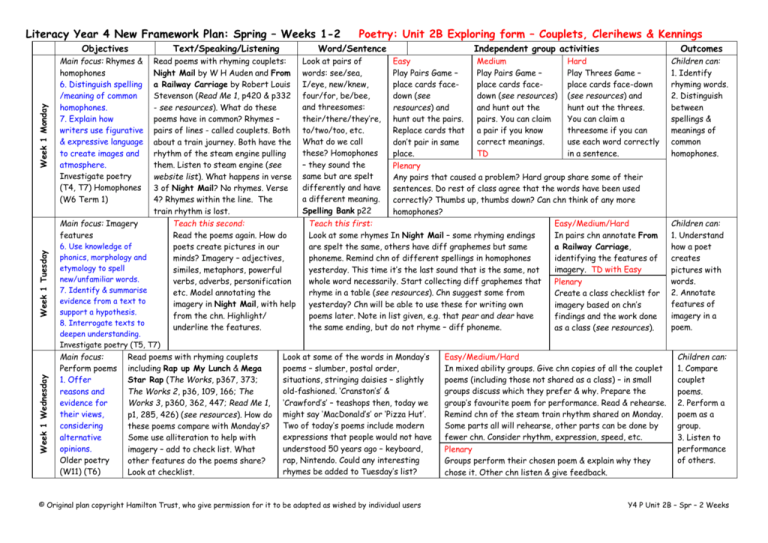
Literacy Year 4 New Framework Plan: Spring – Weeks 1-2 Week 1 Monday Objectives Main focus: Rhymes & homophones 6. Distinguish spelling /meaning of common homophones. 7. Explain how writers use figurative & expressive language to create images and atmosphere. Investigate poetry (T4, T7) Homophones (W6 Term 1) Text/Speaking/Listening Week 1 Tuesday Week 1 Wednesday 6. Use knowledge of phonics, morphology and etymology to spell new/unfamiliar words. 7. Identify & summarise evidence from a text to support a hypothesis. 8. Interrogate texts to deepen understanding. Investigate poetry (T5, T7) Main focus: Perform poems 1. Offer reasons and evidence for their views, considering alternative opinions. Older poetry (W11) (T6) Word/Sentence Read poems with rhyming couplets: Night Mail by W H Auden and From a Railway Carriage by Robert Louis Stevenson (Read Me 1, p420 & p332 - see resources). What do these poems have in common? Rhymes – pairs of lines - called couplets. Both about a train journey. Both have the rhythm of the steam engine pulling them. Listen to steam engine (see website list). What happens in verse 3 of Night Mail? No rhymes. Verse 4? Rhymes within the line. The train rhythm is lost. Main focus: Imagery features Teach this second: Read the poems again. How do poets create pictures in our minds? Imagery – adjectives, similes, metaphors, powerful verbs, adverbs, personification etc. Model annotating the imagery in Night Mail, with help from the chn. Highlight/ underline the features. Read poems with rhyming couplets including Rap up My Lunch & Mega Star Rap (The Works, p367, 373; The Works 2, p36, 109, 166; The Works 3, p360, 362, 447; Read Me 1, p1, 285, 426) (see resources). How do these poems compare with Monday’s? Some use alliteration to help with imagery – add to check list. What other features do the poems share? Look at checklist. Poetry: Unit 2B Exploring form – Couplets, Clerihews & Kennings Independent group activities Outcomes Look at pairs of words: see/sea, I/eye, new/knew, four/for, be/bee, and threesomes: their/there/they’re, to/two/too, etc. What do we call these? Homophones – they sound the same but are spelt differently and have a different meaning. Spelling Bank p22 Easy Medium Hard Play Pairs Game – Play Pairs Game – Play Threes Game – place cards faceplace cards faceplace cards face-down down (see down (see resources) (see resources) and resources) and and hunt out the hunt out the threes. pairs. You can claim You can claim a hunt out the pairs. threesome if you can Replace cards that a pair if you know correct meanings. use each word correctly don’t pair in same TD in a sentence. place. Plenary Any pairs that caused a problem? Hard group share some of their sentences. Do rest of class agree that the words have been used correctly? Thumbs up, thumbs down? Can chn think of any more homophones? Teach this first: Easy/Medium/Hard In pairs chn annotate From Look at some rhymes In Night Mail – some rhyming endings a Railway Carriage, are spelt the same, others have diff graphemes but same identifying the features of phoneme. Remind chn of different spellings in homophones imagery. TD with Easy yesterday. This time it’s the last sound that is the same, not whole word necessarily. Start collecting diff graphemes that Plenary rhyme in a table (see resources). Chn suggest some from Create a class checklist for yesterday? Chn will be able to use these for writing own imagery based on chn’s poems later. Note in list given, e.g. that pear and dear have findings and the work done the same ending, but do not rhyme – diff phoneme. as a class (see resources). Look at some of the words in Monday’s poems – slumber, postal order, situations, stringing daisies – slightly old-fashioned. ‘Cranston’s’ & ‘Crawford’s’ – teashops then, today we might say ‘MacDonald’s’ or ‘Pizza Hut’. Two of today’s poems include modern expressions that people would not have understood 50 years ago – keyboard, rap, Nintendo. Could any interesting rhymes be added to Tuesday’s list? © Original plan copyright Hamilton Trust, who give permission for it to be adapted as wished by individual users Easy/Medium/Hard In mixed ability groups. Give chn copies of all the couplet poems (including those not shared as a class) – in small groups discuss which they prefer & why. Prepare the group’s favourite poem for performance. Read & rehearse. Remind chn of the steam train rhythm shared on Monday. Some parts all will rehearse, other parts can be done by fewer chn. Consider rhythm, expression, speed, etc. Plenary Groups perform their chosen poem & explain why they chose it. Other chn listen & give feedback. Children can: 1. Identify rhyming words. 2. Distinguish between spellings & meanings of common homophones. Children can: 1. Understand how a poet creates pictures with words. 2. Annotate features of imagery in a poem. Children can: 1. Compare couplet poems. 2. Perform a poem as a group. 3. Listen to performance of others. Y4 P Unit 2B – Spr – 2 Weeks Literacy Year 4 New Framework Plan: Spring – Weeks 1-2 Week 1 Thursday Week 1 Friday Objectives Main focus: Write couplets 6. Use knowledge of phonics, morphology and etymology to spell new and unfamiliar words. Develop a range of personal strategies for learning new and irregular words. 9. Show imagination through the language used to create emphasis, humour, atmosphere or suspense. Choose and combine words, images and other features for particular effects. Main focus: Edit & redraft poetry 1. Use ground rules for sustaining talk and interactions. 4. Comment constructively on poetry. 12. Write legibly. Text/Speaking/Listening Poetry: Unit 2B Exploring form – Couplets, Clerihews & Kennings Word/Sentence Independent group activities Outcomes Teach this second: Teach this first: Easy/Medium Hard Use Poetry (see resources, Work in pairs. Use Explain to chn that good poetry Show/remind chn how to use a rhyming the structure of doesn’t have to rhyme but that dictionary/thesaurus. Discuss how to The Works 2, p387) and Alien Lullaby (see it’s part of the structure that find a rhyme - use the alphabet to try make a list of rhyming makes these poems a couplet. single syllable rhymes, then try some resources, The couplets using the same Work together on a poem, common initial blends, e.g. st, bl, pr, etc form, e.g. Not the rain, but Works 2, p388) to modelling finding a suitable or different graphemes that are the the cool touch of rain; Not write own poem. rhyme and going back & editing same phoneme, or multi-syllabic words. the lion, but the lion’s mane. Each couplet is to include a better rhyme (use Or use a rhyming syllable often found Start with the pair of linked. Choose a diff. Mysteries, The Works 4, p423) at the end of words, e.g. ton, tion, able, rhyming words. Each creature, Hush little etc, and try to think of some twosee resources). It is important rhyming couplet does not Hobbit… syllable words that could be used have to be linked to the that a rhyme isn’t used just TD instead. Write example on f/c (see others. Work in pairs. because you thought of it. resources). Note that there are some Perhaps changing the order of Plenary the first line means that you words in English that it is very hard to Ask for volunteers to share some of their couplets. have an easier word to think of a find a rhyme for, e.g. orange, angel, Explain that chn will have time tomorrow to edit & rhyme for. Or use a word that chaos, patient, parent & purple. Avoid redraft their poems. means the same instead. using these! Give chn plenty of time today to edit & redraft their Easy/Medium/Hard poems. Rehearse checklist of how poets create images Chn edit their own work and then share with a response partner using in their work. Remind chn that their poems are being 3 Stars and a Wish (see resources). Allow chn time to redraft as a written using the same structure as Poetry & Alien result of the feedback, checking spelling and handwriting. Have they Lullaby. It is written in discrete lines, unlike prose, used rhymes? TD as required when you carry on writing to the side of the page. Plenary Discuss how to give positive feedback to a response Explain to chn that they will be performing/publishing their poems partner. Remind chn of checklist for imagery. next week, when they have studied some other forms of poetry. © Original plan copyright Hamilton Trust, who give permission for it to be adapted as wished by individual users Children can: 1. Use a rhyming dictionary. 2. Use a thesaurus. 3. Write some rhyming couplets based on a given form. Children can: 1. Edit & redraft their own work. 2. Give positive feedback to others. Y4 P Unit 2B – Spr – 2 Weeks Literacy Year 4 New Framework Plan: Spring – Weeks 1-2 Week 2 Tuesday Week 2 Monday Objectives Text/Speaking/Listening Poetry: Unit 2B Exploring form – Couplets, Clerihews & Kennings Word/Sentence Main focus: Kenning structure 7. Explain how writers use figurative and expressive language to create images and atmosphere. 9. Develop and refine ideas in writing using planning and problemsolving strategies. Identify different forms & patterns of rhyme used in poetry (T7) Independent group activities Outcomes Kennings – Saxon/Norse/Old English word What types of words Easy Medium Hard game. Saxons liked describing their swords in are used? Chn choose an Work in pairs – Work individually – this way, e.g. throat slitter (see resources, Nouns/adjectives animal as a choose an animal choose an animal and followed by a verb, group, and and write down as write down as many The Works, p229). Read two examples (see usually ending in –er write down as many characteristics as resources) Guess Who? (The Works, p227). many ideas as characteristics as they can. Don’t Who is it? - Henry VIII. Squirrel – don’t give suffix. Verb root with suffix added – they can they can. Don’t worry at this stage title! (The Works, p228) – which creature is a person, animal or about it. Use worry at this stage about writing as a it? Pairs of words in each line. Something is thing that performs adjectives, about writing as a Kenning. described without using its name. A type of a specific action or verbs, Kenning. list poem. activity. All lines phrases, etc. Teach word work now. TD scribe Show chn an extract from Happy Feet or clips rhyme because they finish with the same of penguins (see website list). Read Penguin Plenary suffix. (see resources -The Works, p229). Does it Some volunteers share their ideas – can rest of chn work Return to text work. out which animal is being described? describe well what chn saw in clips? Main focus: Write Kennings Read some more Kennings (see resources – The Write desert & dessert on f/c. Easy/Medium/Hard What sort of words are these? Working in groups, pairs or 4. Comment constructively on Works, p230; The Works 2, p64, 153, 405; The Homophones? No – pronounced individually as yesterday, chn poetry. Works 3, p10, 404, 478; The Works 4, p16, 95). differently. What do they both use their notes to write a Identify different forms of Can chn work out what each poem is describing? mean? There are many pairs of Kenning poem about their animal. poetry (T7). Look at the verbs – powerful – really help to similar words that people (inc. lots TD as required 6. Distinguish the spelling and create an image in your mind. Look at a few of adults) mix up, both confusing meaning of common homophones. details, e.g. Inventions I’d Like to See - there is Plenary Develop a range of personal an internal rhyme in each line; The Thingy & Tiger the spelling, but also the meaning. Share their Kennings with They are often homophones, e.g. strategies for learning new and both have pairs of rhyming lines like a couplet – another group, pair or individual draw & drawer. Look at some irregular words. kicker/flicker, splasher/flasher. Note how some & give feedback as last week. common examples together (see 9. Choose and combine words, poets used a hyphen for each pair of words. A Time will be given later in the images and other features for resources). display of Kennings for chn to work out what is week to edit & redraft their particular effects. being described is a useful stimulus for work. Write poems based on forms discussion at this point. read (T11) © Original plan copyright Hamilton Trust, who give permission for it to be adapted as wished by individual users Children can: 1. Describe the structure of a Kenning. 2. Brainstorm some ideas about a particular animal. 3. Identify characteristics of a particular animal. Children can: 1. Distinguish between pairs of words that are often confused. 2. Write in the form of a Kenning. Y4 P Unit 2B – Spr – 2 Weeks Literacy Year 4 New Framework Plan: Spring – Weeks 1-2 Objectives Text/Speaking/Listening Poetry: Unit 2B Exploring form – Couplets, Clerihews & Kennings Word/Sentence Independent group activities Outcomes Week 2 Wednesday Clerihews – a four-line comic verse of two rhyming Write the words cough, Easy/Medium/Hard Children can: couplets. The lines can be of any length but the first through & bough on f/c. What Challenge chn to work in pairs to 1. Understand involves the name of the person being written about. do chn notice? All the words write a Clerihew about a famous that the same Invented by E. Clerihew Bentley who died in 1956 – hence have the same ending. Are person. It’s easier if they pick grapheme can the name! Read the one that explains this (see resources, they pronounced the same? No! someone that they have some be pronounced Can chn think of other words information about – and the person’s The Works, p251) and then a few other examples (see in different with same ending? Which of name needs to be easy to find a ways. resources, The Works, p251, 252, 253). Brainstorm some the 3 original words do they rhyme with for the second line of the 2. Write a names of well-known people. Can chn think of rhymes for rhyme with? Although, though, poem. Encourage Hard group to use Clerihew. their names? How could the words be used to describe rough, dough, enough, plough, double syllable rhymes. TD as req’d Hard that person? Notice that one poet used two words to thorough, dough. Spelling Bank Plenary 3. Use double make the rhyme, e.g. Austin/lost in; and others used more p29. Which other graphemes syllable rhymes. than one syllable, e.g. Ow en/glow ing, Drac ula/spectac Pairs share their work with each ular. Some examples of rhymes with well-known names are rhyme with the three other and give positive feedback. phonemes? given in the plan resources. Access to an ICT Suite will be useful on Thursday and Friday for chn to word-process their poetry. Teacher should be familiar with MicrosoftTM Sound Recorder (see resources) for Friday’s lesson. Or chn can use a tape recorder. Main focus: Edit and redraft own work Look back at the three poetry types discussed. What Easy/Medium/Hard Children can: do they all have in common? Rhyming. Pairs (either of Give chn plenty of time to edit and redraft their 8. Read extensively favourite authors or 1. Discuss lines or words). Which do chn prefer? Why? Compare Clerihews, Kennings and if necessary their couplets genres and experiment with other types poetry forms. the structures. Explain that chn are going to publish from last week. Start preparing written or wordof text. 2. Edit & their poems in a class book or on a class tape/CD. They processed poems and rehearse spoken poems. Write poems based on forms read (T11) redraft own will have time today to edit and redraft their work and TD as required 12. Write consistently with neat, legible work. begin to write it in a neat cursive style or use ICT to and joined handwriting. 3. Give positive Plenary present it. Remind chn about the imagery checklist. Use word-processing packages to Check that chn have a final draft of their poem(s) ready feedback to Have they used rhymes? Does the structure of the present written work and continue to others. for publication in written or spoken form tomorrow. poem follow the correct form? increase speed and accuracy in typing. Main focus: Publish work Give chn plenty of time Easy/Medium/Hard Children can: today to complete the Chn write, type or speak their finished poem(s) in class book or 1. Tell poetry effectively. 1. Use ICT to final draft of their on tape/CD. Chn could add an illustration to written work – 3. Take different roles in groups. present their work. poems. Some will be clipart, hand-drawn or downloaded picture. Chn could add sound 12. Write consistently with neat, legible and joined 2. Use neat cursive individual, some paired effects to recorded poems. handwriting. handwriting to and some group work. Use word-processing packages to present written work present their work. Plenary and continue to increase speed and accuracy in typing. 3. Work Collate a book of written poetry for chn to read during quiet Write poems based on forms read (T11) collaboratively. reading. Listen to tapes/CDs of spoken poetry. Week 2 Friday Week 2 Thursday Main focus: Clerihew structure 6. Use knowledge of phonics, morphology & etymology to spell new & unfamiliar words. Spell words with common endings (W6) 9. Choose & combine words, images & other features for particular effects. Write poems based on forms read (T11) Scroll down for success criteria and book and website list. © Original plan copyright Hamilton Trust, who give permission for it to be adapted as wished by individual users Y4 P Unit 2B – Spr – 2 Weeks Literacy Year 4 New Framework Plan: Spring – Weeks 1-2 Poetry: Unit 2B Exploring form – Couplets, Clerihews & Kennings Success criteria for the block – these should be selected & adjusted to match the specific needs of the class being taught. Easy Medium Hard Begin to identify rhyming words Be aware that common homophones have different spellings & meanings Understand how a poet creates pictures with words With support annotate features of imagery in a poem Compare couplet poems Perform a poem as a group Listen to performance of others With help use a rhyming dictionary Begin to use a thesaurus Write some rhyming couplets based on a skeleton form With support edit & redraft their own work Give positive feedback to others Begin to recognise the structure of a Kenning Brainstorm some ideas about a particular animal Identify characteristics of animal Write in the form of a Kenning Be aware that the same grapheme can be pronounced in different ways Write a Clerihew Discuss poetry forms Use ICT to present their work Use neat cursive handwriting to present their work Work collaboratively Identify rhyming words Begin to distinguish between spellings & meanings of common homophones Understand how a poet creates pictures with words Annotate features of imagery in a poem Compare couplet poems Perform a poem as a group Begin to use a rhyming dictionary Use a thesaurus Write some rhyming couplets based on a given form Edit & redraft their own work Give positive feedback to others Recognise the structure of a Kenning Brainstorm some ideas about a particular animal Identify characteristics of animal Distinguish between pairs of words that are often confused Write in the form of a Kenning Understand that the same grapheme can be pronounced in different ways Write a Clerihew Begin to use double syllable rhymes Discuss poetry forms Use ICT to present their work Use neat cursive handwriting to present their work Work collaboratively © Original plan copyright Hamilton Trust, who give permission for it to be adapted as wished by individual users Identify rhyming words Distinguish between spellings & meanings of common homophones Understand how a poet creates pictures with words Annotate features of imagery in a poem Compare Couplet poems Perform a poem as a group Listen to performance of others Use a rhyming dictionary Use a thesaurus Write some rhyming couplets based on a given form Edit & redraft their own work Give positive feedback to others Describe the structure of a Kenning Brainstorm some ideas about a particular animal Identify characteristics of animal Distinguish between pairs of words that are often confused Write in the form of a Kenning Know that the same grapheme can be pronounced in different ways Write a Clerihew Use double syllable rhymes Discuss poetry forms Use ICT to present their work Use neat cursive handwriting to present their work Work collaboratively Y4 P Unit 2B – Spr – 2 Weeks Literacy Year 4 New Framework Plan: Spring – Weeks 1-2 Poetry: Unit 2B Exploring form – Couplets, Clerihews & Kennings Books: Read Me 1 chosen by Gaby Morgan (Macmillan, ISBN 0-330-37353-6) The Works chosen by Paul Cookson (Macmillan, ISBN 0-330-48104-5) The Works 2 chosen by Brian Moses & Pie Corbett (Macmillan, ISBN 0-330-39902-0) The Works 3 chosen by Paul Cookson (Macmillan, ISBN 0-330-41578-6) The Works 4 chosen by Pie Corbett & Gaby Morgan (Macmillan, ISBN 0-330-43644-9) Poems Night Mail by W H Auden (p420, Read Me 1 or p520, The Works) From a Railway Carriage by Robert Louis Stevenson (p332, Read Me 1) Rap up My Lunch by Andre Fusek Peters (p362, The Works 3) Mega Star Rap by Valerie Bloom (p166, The Works 2) Mysteries by Pie Corbett (p423, The Works 4) Poetry by Eleanor Farjeon (p387, The Works 2) Alien Lullaby by Sue Cowling (p388, The Works 2) Squirrel by Celia Warren (p228, TheWorks) Penguin by Sue Cowling (p229, The Works) Edmund by Paul Cookson (p251, The Works) Websites: Steam engines (need QuickTime installed – free download http://www.apple.com/quicktime/download/) http://www.bluebell-railway.co.uk/bluebell/sounds/73082.mp3 http://www.steamsounds.co.uk/audio0703/cd20_157.mp3 http://www.steamsounds.co.uk/audio0703/cd20_166.mp3 Penguins: http://www.boreme.com/boreme/search/penguin-movie.php short clips http://video.google.co.uk/videoplay?docid=1688669524881784275&q=genre%3AMOVIE_TRAILER+duration%3Ashort&total=44788&start=0 &num=10&so=0&type=search&plindex=1 Happy Feet film © Original plan copyright Hamilton Trust, who give permission for it to be adapted as wished by individual users Y4 P Unit 2B – Spr – 2 Weeks
